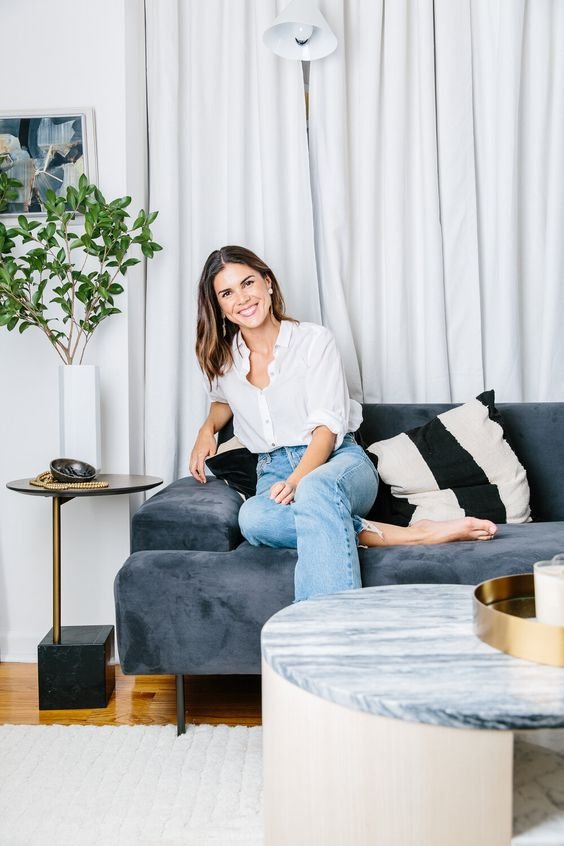How many times have you peered voyeuristically into the lives of people you admire via social media, video, or published interviews and wondered what it must be like to do their job? We’ve all been down that research rabbit hole on our quest to create and cultivate the career of our dreams, but often we’re still left pondering about the realities of their day-to-day—so, what is it really like? Well, in this series, I Want Your Job we uncover the truth by getting down to the nitty-gritty on what it’s actually like to work in your quote-unquote “dream job” and if the reality stacks up to the expectation. Up next, Sophie Miura, Digital Content Director at Domino.
When it comes to your career trajectory, there really is no clear path anymore (or a gold watch at the end!). Today, it’s fraught with twists and turns, ups and downs, curves, and sideway maneuvers but that’s what makes it so exciting. Sure, there are challenges along the way, even a few mistakes, and wrong turns, but ultimately, we all land where we’re meant to be. And oftentimes, it’s in a position you never expected to be in either.
This was the case for Sophie Miura. While she had a passion for media, she was unsure of which area to pursue, so she tried them all—from radio to broadcast, print and digital—until she found the one she really loved: magazine publishing. But breaking in and landing a job in the very competitive world of magazines wasn’t easy.
Read on to learn how Miura interned her way to the Digital Content Director at Domino (where she has helped to launch compelling new series, such as New Voices, that spotlight and celebrate women who are shaping the design world), the lessons she’s learned along the way, and why she believes in the importance of on-the-job experience.
I Interned Everywhere to Get My Foot in the Door
As soon as I finished high school, I started interning and worked at almost every type of media outlet, from broadcast radio to television, until I found one I really loved: magazine publishing. When I wasn’t studying media and communications at university, I was interning at Hearst, and, after three months of fetching coffee, organizing the fashion closet, and sourcing rare purebred dogs for a cover shoot (yes, really), I scored a full-time offer as the assistant to the editor in chief—I was ecstatic!
I spent four years working my way up, from picture and production editor to health and features writer. Then, the magazine closed. I was devastated, but ultimately, there was a silver lining: I was invited to join the launch team of Elle Australia. It was a crazy experience, and I learned to be incredibly resourceful and do whatever I could to just get the job done. By age 25, though, I was totally burnt out. I took a giant leap and quit my job, bought a one-way ticket to Bangkok, and spent five months backpacking without a plan. It was so liberating after spending my early twenties working so hard.
I was so worried that it would halt my career but it actually did the opposite. I knew two things by the time I finished traveling: that I wanted to live overseas and that I loved writing about travel. I reached out to every person I knew in publishing, sent a lot of cold emails, and after a lot of hustling, landed a job as a lifestyle editor at MyDomaine in New York. It was a whirlwind. I traveled to far-flung destinations like the Arctic Circle and Bora Bora to write about new hotels and airlines as I cut my teeth as a digital editor.
All in all, I must have done at least six internships before landing a full-time role. It was the best way to figure out what kind of career I actually wanted. Certain media roles sound impressive but are completely different in reality. Interning helped me to fast-track that learning experience and really zero-in on what I wanted to do.
On-the-Job Experience Often Trumps a Degree
I have a Bachelor of Arts in media and communications. It was a great entry course but the best experience I had was on the job. If I hadn’t consistently interned while studying, I don’t know where I’d be.
I Set an Agenda Each Morning and Prioritize Tasks
I’m the digital content director at Domino, which means that I oversee digital editorial as well as the social media and email team. My days are pretty varied, but typically, I’m in the office early and use that first hour of silence to do the most important tasks: I set an agenda for the day (I find that three priority tasks are realistic; any more is a stretch), review our daily content mix, take stock of industry news and competitor coverage, and dive into overnight traffic to make sure I’m across any fluctuations. The rest of the day tends to be dominated by meetings! I manage a team of eight and work with the print and branded content teams so face time is really important.
I Have My Dream Job, But Reality Doesn’t Always Match Expectations
It’s much more strategic and team-facing than my last role, which was a senior editor at MyDomaine. Fortunately, Domino is a pretty flexible workplace and we’re really encouraged to shape our own roles. When I crave a dose of creativity, I jump into a brainstorm or workshop stories with our editors.
There’s much more to my job than overseeing the website. What you see (whether it be on Domino.com, Instagram, or our other social channels) is really a fraction of the role. It’s much more numbers-based than you’d expect.






















